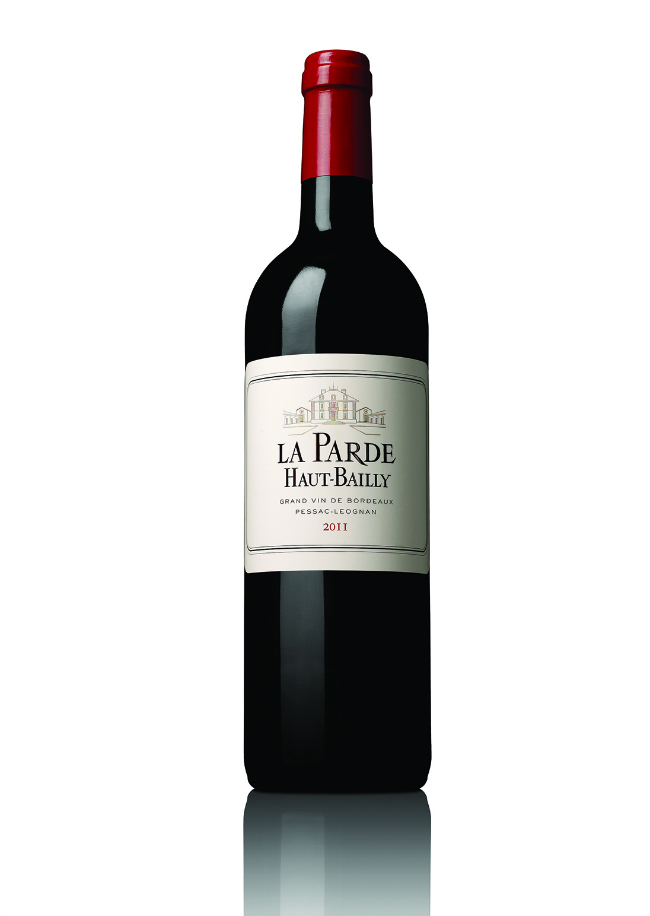In Bordeaux Wine Country, Generations of Care at Château Haut-Bailly


Armed with dangerously little knowledge I still find that many of my wine discoveries are serendipitous. Recently I was staying overnight at Château Le Pape, not far from the busy centre of Bordeaux. I can’t recommend this place enough – an elegant guest house set in its own vineyards. It’s filled with light, and restored, decorated and furnished with peerless taste and style.
A browse through the family albums in the comfy library reveals that the owners of this château B&B and its vineyard are also the people behind Château Haut-Bailly, something of a legendary name in Bordeaux wine history. How could I resist an invitation to their private dining room for lunch on a sparkling Autumn day?

2007 Château Haut-Bailly
Over lunch with Anne-Sophie Brieux, we discuss the unique terroir and the craftsmanship that’s required to produce one of Bordeaux’s finest wines. We are in the appellation of Pessac-Léognan just to the South of Bordeaux – this is Graves country, home of the iconic Château Haut-Brion (mentioned by Samuel Pepys, no less, in 1663) and, as the Romans first discovered, there’s a microclimate here with a good mix of sunshine and humidity. The underlying soil is sand and gravel (hence ‘Graves’) and at Haut-Bailly the ploughing and turning of the shelly sub-soils brings up fossils which are displayed on the cellar walls.
Haut-Bailly’s special terroir has attracted a series of owners dating back to the 15th century, but its reputation was massively enhanced under the stewardship of Alice Bellot des Minières who acquired it in 1872. During the terrible phylloxera outbreak which destroyed nearly all of the Bordeaux vineyards, des Minières defied the conventional rescue plan of grafting native vines onto imported American stock and decided to persevere with some of the native vines. As a result, Haut-Bailly has inherited some of the oldest vines of Bordeaux on its estate, a quarter dating back 100 to 120 years. Sadly, the ravages of two world wars took their toll on the estate, which went into decline for many decades; until a Belgian, Daniel Sanders, bought it in 1955 and began to renovate the vineyards leading to a gradual rediscovery of the unique quality of the wine.
Then, in 1998, a fairy godfather appeared on the scene in the shape of Robert Wilmers, an American Francophile banker who grew up in Belgium, carved out a successful career in the US financial services industry, and along the way managed to acquire a French wife and a love of Bordeaux wine. Under his direction and with much love and investment the château has gone from strength to strength. The heritage of Haut-Bailly, its winemaking traditions and its unique terroir have been respected at every step of the way, garnering kudos and appreciation amongst the small circle of great château owners. In 2016, the domaine was awarded the prestigious label Entreprise du Patrimoine Vivant by the French State in recognition of their winemaking skills and craft which contribute to the preservation of their heritage.

wine by Château Haut-Bailly
A LINK TO THE PAST
The appointment of talented winemaker Véronique Sanders-van Beek as general manager, herself the great-grand daughter of Daniel Sanders, is testimony to the owner’s desire to maintain links with the past. Under her management the château produces a select range of wines: La Parde Haut-Bailly, their second wine which celebrates its 50th anniversary in 2017; Rose de Haut-Bailly, a unique rosé; Pessac-Léognan, their third wine made from younger vines, and more recently Château Le Pape, a fruity Merlot. But it is the first wine, Château Haut-Bailly Cru Classé de Graves, with its unique blend of 60% Cabernet Sauvignon, 34% Merlot, 3% Cabernet Franc and 3% Petit Verdot, which has produced consistently fine vintages over the last ten years and received rave reviews.
The winemakers’ skill and craft come to the fore with the emphasis on close observation, relentless grape selection, careful pruning and harvesting, and meticulous blending and tasting. Hardly a year goes by without another great vintage to add to the prestige of Haut-Bailly. Last year Robert Parker re-tasted the 2009 and revised his score to the maximum 100, describing it as “one of the perfect wines of this great, great vintage”.
Over lunch I was able to taste the La Parde de Haut-Bailly 2011, a smooth and fresh wine that was a surprisingly perfect match for a light premier plat of fish. But the knockout came with our main course in the shape of a 2007 Cru Classé. Heaven in a glass. So velvety and subtle, yet so concentrated. Exquisite on first sip and with a lingering aftertaste. Elegant perfection. Hang the expense – this would truly enhance any special occasion in life.
For more information visit www.haut-bailly.com
Related articles: Great Destinations in France, Bordeaux Wine Country
Things to See and Do in Bordeaux: A Comprehensive Guide
Where to Stay and Eat in Bordeaux Wine Country
From France Today magazine
Share to: Facebook Twitter LinkedIn Email
By Guy Hibbert
Leave a reply
Your email address will not be published. Required fields are marked *




REPLY